
June 2009 E-P1 - First MTF camera from Olympus
|
![]() Released on the world in a fanfare of publicity in Berlin (June 2009) the first in a series of MicroFourThirds cameras - the Digital PEN E-P1 - appeared. Olympus believe this camera will revive their fortunes and fill a new market segment for those looking for a small camera with the image quality of a DSLR. Olympus are convinced that many compact users refuse to step up to DSLR because they are too big and complex. The E-P1 is neither. Released on the world in a fanfare of publicity in Berlin (June 2009) the first in a series of MicroFourThirds cameras - the Digital PEN E-P1 - appeared. Olympus believe this camera will revive their fortunes and fill a new market segment for those looking for a small camera with the image quality of a DSLR. Olympus are convinced that many compact users refuse to step up to DSLR because they are too big and complex. The E-P1 is neither.
To see more click the body icon.
|
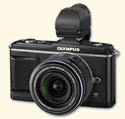
March 2010 E-P2 - with attachable EVF
|
After the E-P1 was released Olympus received much criticism that the camera did not have a viewfinder, relying entirely on the LCD - like a compact. Taking the lead from Panasonic, Olympus develops the VF-2, a new breed of EVF being high resolution, bright and high on contrast. Early versions of the E-P2 come bundled with the new electronic viewfinder. EVF available as accessory.
To see more click the body icon.
|

Sept 2010 E-PL1 - Lite Version mFT goes downmarket
|
Olympus releases its third mFT version with full plastic body and integrated on-board flash as well as the communications port enabling the use of the VF-2 EVF as well as SEMA-1 Hi-Fi recording device. This latest version features the new True-Pic V jpeg engine delivering stunning out of camera images, making the need to process RAW data almost redundant.
To see more click on body icon.
|

March 2011 E-PL2 - Second 'Lite' PEN version
|
Second 'Lite' mFT version with full plastic body and integrated on-board flash. This camera has the new AP2 accessory port enabling the use of the VF-2 EVF and other newer accessories. This latest version includes an updated True-Pic engine and a new version of the standard MZD14-42mm lens that is designated MSC - Movie & Still Compatible. This has increased its AF speed.
To see more click on body icon.
|

June 2011 E-P3 - Gets a new sensor and fast AF
|
Olympus releases the E-P3 which promises to silence critics of the slow AF system by doubling the sensor and processing speed thus providing the fastest AF of any DSLR machine. The E-P3 boasts an on-board flash and AF assist lamp as well as a detachable grip and a host of other improvements.
To see more click on body icon.
|

August 2011 E-PL3 - Slim version with tilt screen
|
Third 'Lite' mFT version; the E-PL3 is a slimmer version with no on-board flash and a tiltable rear screen ala C5050/C8080. Does accept the VF-2 electronic viewfinder and other accessories in the port AP2 and includes the AF assist lamp.
To see more click on body icon.
|

September 2011 E-PM1 - Smallest mFT camera yet
|
Entirely new micro machine from Olympus, the E-PM1 is purported to be the smallest mFT camera. Ultra slim and small dimentions it is almost exclusively automatic in operation and aimed squarely at those migrating from compacts. Has the AP2 port and AF assist lamp.
To see more click on body icon.
|
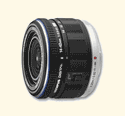
MZD 14-42mm I standard zoom
|
Introduced with the E-P1 is the Micro Zuiko Digital version of the 4/3rds standard zoom, the MDZ 14-42mm/f3.5-5.6. To match the E-P1's petiteness its zoom needs to be as small as possible and Olympus made this lens collapsible. With a small locking device on the barrel the lens can cleverly retract itself giving the impression of smallness.
To see more click the lens icon.
|
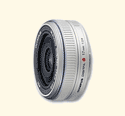
MZD 17mm Pancake
|
To continue the theme of compactness set by the E-P1, the 17mm/f2.8 W/A pancake is produced. With an effective angle of view of a 35mm wide-angle lens the Pancake is ideal for street photography and unintrusive image capture.
To see more click the lens icon.
|

MZD 14-42mm MSC standard zoom
|
Reacting to the criticism of slow AF Olympus develops the MSC version of the standard zoom first seen on the E-PL1 in Japan and on the E-PL2 rest of the world. Faster AF on all Pens with this lens.
To see more click the lens icon.
|

MZD 14-42mm IIR MSC
|
A second version known as the IIR MSC of the standard zoom arrived with the E-P3 in June 2011. It is remarkably fast on the E-P3 and makes other Pens quicker too. Different finish with detachable dress ring.
To see more click the lens icon.
|

MZD 9-18mm Wide-angle zoom
|
The first W/A zoom lens for the Olympus mFT system is the ultra wide-angle MZD 9-18mm zoom lens. This is a high quality UWA zoom that is capable of being stored in the collapsed position making it very portable indeed.
To see more click the lens icon
|

MZD 14-150mm MSC
|
This ultra zoom is a great carry round lens giving a 35mm equivalent coverage of 28-300mm. Very capable and sharp too.
To see more click the lens icon.
|

MZD 40-150mm I
|
Borrowing this design from the popular E-System lens this is an economy zoom with a great spread (35mm equivalent) of 80-300mm.
To see more click the lens icon.
|

MZD 40-150mm IIR MSC
|
Second version of this lens is faster and quieter for movies. There are cosmetic changes too.
To see more click the lens icon.
|

MZD 75-300 MSC
|
Ultra long telephoto zoom with 35mm equivalent of 150-600mm. Fast AF and silent in operation for movies.
To see more click the lens icon.
|

MZD 12mm x f1.8 Super Wide Angle
|
Available from August 2011 this is Olympus' first W/A fast prime lens for the Pen series.
To see more click the lens icon.
|

MZD 45mm x f2.0 Portrait
|
Available from September 2011 comes a fast prime portrait lens for the Pen system.
To see more click the lens icon.
|
|
|
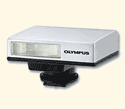
The dedicated flash FL14
|
Specifically designed to compliment the Digital Pen, the FL14 boasts a Guide Number of 20 and has full integration with the Digital Pen. Its horizontal design reflects the retro design of the E-P series (and E-Series cameras. The flash does not have a moving head and does not support swivel/bounce.
To see more click the flash icon.
|

FL-20 - mini flash unit
|
Coming primarily from the Camedia C-series range of compact machines the FL-20 is an all purpose but restricted small, lightweight and pocketable flash unit. Seamless integration with the Digital Pens and E-System bodies. Limited output, fixed head. Operates on 2 rechargeable NiMH AA's.
To see more click the flash icon.
|
|
|
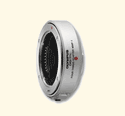
Lens Adapter MMF-1
|
This adapter allows the mounting of all Olympus standard 4/3rds lenses on the Digital Pen. Such lenses retain all their capabilities such as AF. This effectively extends the range of lenses available to the Pen. Those 4/3rds lenses which are CDAF enabled work the same as specific MFT lenses; others work satisfactorily but the contrast detect auto focus is a little slower.
To see more click the accessory icon.
|
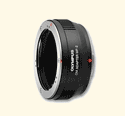
Lens Adapter MF-2
| This adapter allows the direct mounting of the huge range of OM lenses to the Digital Pen. The shorter flange distance of MFT allows the use of many older legacy lenses and many adapters allowing legacy lenses from other manufacturers are being made.
To see more click the accessory icon.
|
|
|













